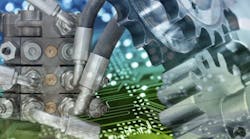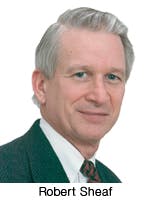The fluid power industry’s manufacturers and distributors had a fairly good year in 2013—better than fairly good, in some cases. Doug Racine, North American distribution manager for Ross Controls, called 2013 “a really good year” and one of the company’s best ever. Ross Controls is headquartered in Troy, Michigan, so it is no surprise that the resurgence in automotive business had a positive effect on the company.
“Sales have been strong. I mean, we’re still dependent on a strong automotive industry [and] automotive was strong,” Racine said. “Also, ever since things went bad in 2008-09, we’ve become leaner and more efficient. As sales have returned to the pre-2008 levels, combined with the improved efficiency, our results have been good.”
Fluid power products are still in demand, and many industry executives expect that to continue. One development they have seen in recent years in fluid power technology is a greater use of electrical and electrical-related innovations, especially in automation and some process controls.
“Hydraulics and electronics are becoming more and more intertwined,” said Brett Holmes, account manager for Hydraquip in Houston. “There is more electrical stuff being implemented into hydraulic systems to monitor them, give feedback, [and] that kind of [thing]. We’re seeing a lot going in that direction, more turnkey systems where you can provide some of the electrical stuff with the hydraulic stuff to make it a more complete package. That’s becoming more and more common as well.”
Jean Knowles, general manager at Spencer Fluid Power, in Kent, Washington, and Air-Hydraulic Systems, headquartered in Plymouth, Minn., added that more of Spencer Fluid Power’s business is mobile-related.
“In the mobile market there are a tremendous amount of platforms that are getting far more sophisticated,” she said. “Platforms these days are now integrating electronics on a greater scale. In some cases, mobile can monitor locations, [provide] meaningful metrics [for] fuel, viscosity, [and] energy consumption.”
Bob Sheaf, president of CFC Industrial Training based in Fairfield, Ohio, said he agrees that the increased use of electrical components is due to customer demand and that the trend should continue.
“The industry, especially the distributors, has really gone from being very strong hydraulically to having to move into electronic controls,” Sheaf said. “The colleges are basically training electrical engineers and mechanical engineers, but there is very little [as far as] fluid power engineers out there. If you come out of college and you’re given a task to accomplish something, a lot of people, the majority of them, look at it from an electrical standpoint as opposed to … a hydraulic application.”
At Ross Controls, Racine also has seen more electrical influence being absorbed into fluid power applications. He noted better-made electrical components as a factor.
“More and more applications that used to be either hydraulic or pneumatic have gone electric simply because the electric gives you a little bit finer control of movement,” Racine said. “One of the issues in the past with electric has been the durability and reliability, the robustness of the products. But I think manufacturers of those products have made improvements such that they become more reliable and so they are being applied more often.”
Both Knowles and Racine agreed that while customer demand has driven a lot of these innovations, a company cannot just try out a fluid power “hydraulic-electric” combination because of market demand. Research and cooperation between business partners is crucial, Knowles said.
“I think as a businessperson it’s always good practice to do your due diligence on any products,” said Knowles. “The higher the caliber of the business partner, the greater the probability that the product has already been thoroughly tested and can be supported.”
While it can make for a constant learning curve, Holmes is enthusiastic about electronics’ influence in the fluid power arena and thinks there is much compatibility.
“There are a lot of similarities between electronics and hydraulics. There are some basic principles that are similar, so hopefully that can make the transition to learning it a little easier,” Holmes said.
Still, Holmes advised that those in the fluid power industries should avoid merely copying what they think is the latest cool-looking product and should instead keep their eyes focused on the bigger picture—customer service.
“In order to be competitive, you don’t want to just say ‘Hey, look. I can do that, too.’ You have to be more of a solutions provider,” Holmes said. “Think a little bit outside the box based on whatever the customer needs. You want to say, ‘Here is a different way of doing that same thing.’ It may not always be less expensive upfront, but it may give them some functionality and features that allow them to run more efficiently.”
Racine also cautioned that jumping on an innovation bandwagon is ill advised. Business should maintain a balance between being impressed with new technology while listening to customer demands as well.
“At the end of the day, no matter what the innovation is, if your customer wants it, you need to provide it. And if they don’t want it, then it doesn’t matter how great an idea it is,” Racine said. “We’re very customer focused and very customer driven, especially when it comes to new product development.”
However, some executives are concerned that the industry will not attract talented employees, especially younger employees, to keep up with the product demands and innovations. As part of this, Knowles pointed to the retiring workforce and replacing those experienced and talented people.
“Those who can manage succession successfully and bring in talent along the way will be able to weather that crisis,” she said. “It’s a tremendous amount of knowledge walking out the door every time we have a retirement. I have three managers here who have worked for this company longer than I have been alive.”
While the old sales axiom used to be “always be closing,” many engineers working in fluid power now say “always be learning.”
“We need to know not only fluid power but mechanical engineering, electrical engineering, electronics,” Knowles said. “These competencies should be known but also symphonic in their interactions.”
Holmes sees the influence of electrical as more promising than intimidating.
“Hydraulic has its advantages over electrical and electrical can have its advantages over hydraulics in certain instances,” he said. “We’re always competing, so to speak, against electrical. And it’s kind of odd now that we’re implementing electrical-type systems more and more into our hydraulics … There are some similarities there, but it’s a matter of having an open mind and trying to grasp that, which is not always easy to do.”










